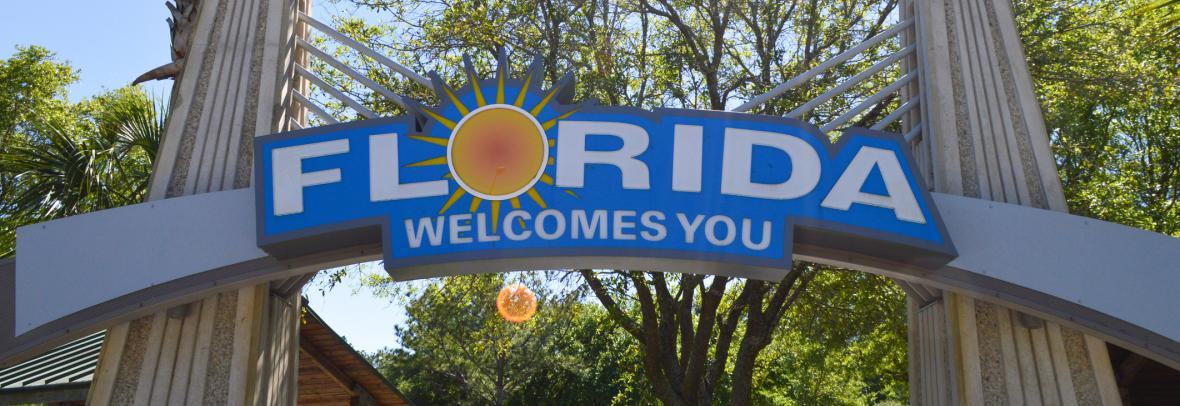
The Census Bureau says Fla. is now the nation’s fastest growing state, a rank it hasn’t held since 1957. Why? Taxes often get some credit, but it’s mainly the sunshine.
WASHINGTON – Florida is the fastest-growing state in America for the first time since 1957, according to the U.S. Census Bureau. The population in the southeastern state, which is known for its warm weather and sandy beaches, now tops 22 million.
“I hate being cold,” says Kathy Bonini, 42, who grew up in Pennsylvania but moved to Florida in 2011. “Everybody loves sunshine and palm trees.”
Nancy Sikes-Kline, mayor of the Florida port city of St. Augustine, agrees.
“You know, we call ourselves ‘the sunshine state’ and I think that that makes a big difference,” Sikes-Kline says when asked why people relocate to her state. “I think, at the very core, it’s just this wonderful weather that we have. The sunshine.”
Florida is known for attracting older, retired Americans. But more than 700,000 people of all ages moved to the state between April 1, 2020, and July 1, 2022. That was during the COVID-19 pandemic, a time when many remote workers could live wherever they wanted.
Economist Sean Snaith says there are factors other than the weather that draw people to Florida, including a robust labor market and the fact that, unlike most U.S. states, Florida has no state income tax.
“Depending on where folks are moving from, that might be an extra 8, 9, 10% of your pay that you get to keep that previously went to pay state taxes or other local taxes,” says Snaith, an economics professor at the University of Central Florida and director of UCF’s Institute for Economic Forecasting.
An analysis of Census data shows that people within the United States who move to Florida most frequently come from New York, Georgia, Ohio, Pennsylvania and California.
“Time to kind of get out of California with the wildfires and the high cost of living,” says Florida resident Aaron Dan, 36, who moved from the West Coast in May 2021, during the pandemic. Dan, who works in real estate, sees more opportunities for land development and commercial leasing in Florida. “You can get a lot more for your dollar around here, lower taxes, obviously,” he says. So, I think just the cost of living is very attractive as well as the opportunity for growth.”
Even before the pandemic, nearly two-thirds of the people who lived in Florida came from out of state. One-fifth of those transplants relocated from a foreign country.
“We’ve had a lot of international in-migration to the state from a variety of locations. You know, it’s not just one or two countries, it’s Central America and South America, the Caribbean,” Snaith says. “People want to move to the United States, in general, and Florida tends to get a larger chunk of those immigrants.”
But population growth can make life in the Sunshine State more expensive. The average price of a home in Florida rose 14% in the past year, compared with the national average of 8.7%, according to Zillow, a real estate marketplace company.
“Florida is kind of a cheap place to buy a house and to live. That’s become less the case,” Snaith says. “So that is making life difficult in terms of affordability. And that’s one of the problems that Florida is going to be grappling with here, I think, for some time to come.”
Realtor Sharon Wooten is a Florida native. Over time, she’s seen orange groves give way to housing developments.
“It’s changed a lot. The farmland is gone. I think if we take care of our natural resources, and we don’t grow too fast, it’s OK. And, I think, if we are choosy about what comes in. A lot of these developments are very, very nice and they take care of these developments and everything they do is top notch,” she says. “As long as it’s good growth, it’s OK. You know, it’s brought in a lot of opportunities for people in this area that they may not have ever had.”
Wooten says the increased development has had a positive impact on daily life for some.
“My mother and my grandmother have had opportunities to shop and go to plays and restaurants and things that they didn’t have before,” she says. “So, it’s just sort of opened up a new world to them.”
Snaith says that, as far as the economy is concerned, population growth is “nothing but good news.”
“Every new household that moves to Florida needs a place to live, they need food, they need medical care, their children, if they have them, need schooling, and they clothe them. They need all the things that consumers buy,” Snaith says. “So, you know, population growth is one side of the coin. The flip side of that same coin is economic growth. … The more people you have in any regional economy, the more economic activity they will generate.”
Florida is the third-most-populous state in the country. People have been moving there since the 1950s, when air-conditioning first became commonplace, and that influx shows no signs of letting up.
“Unless there’s some sort of a dramatic change to, you know, the environment, politically, economically,” Snaith says, “I just don’t see any kind of factor that would take us off this course that the state’s been on for a long time.”
Copyright © 2023 Federal Information & News Dispatch, Inc.
Go to Source
Author: kerrys



